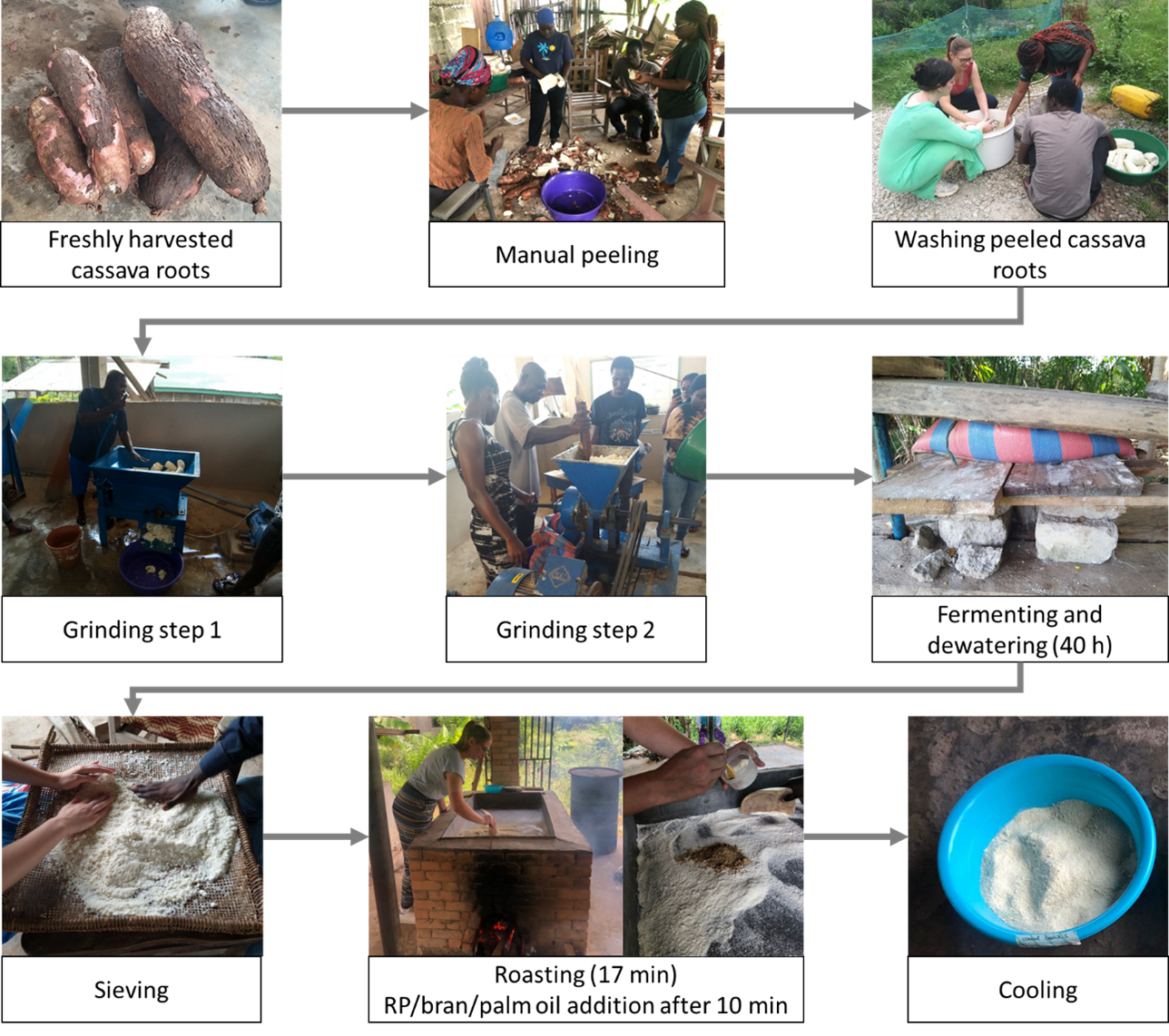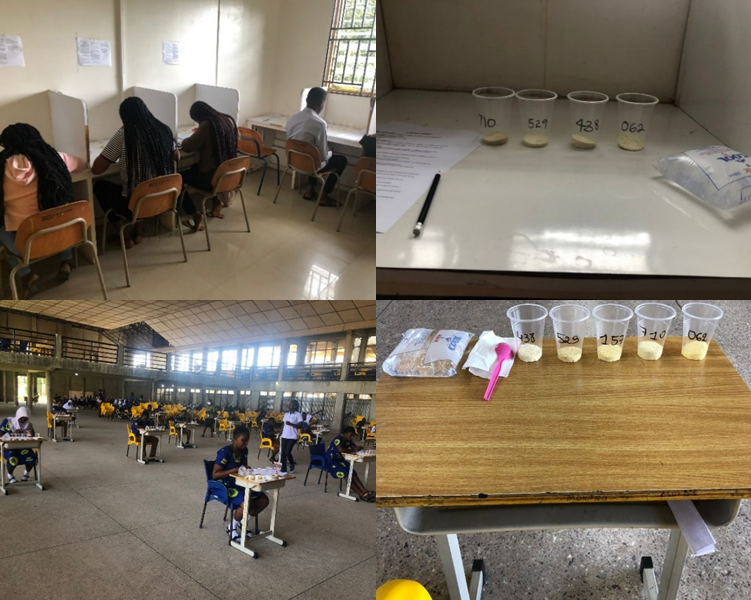Exploring gari's potential as a vehicle for vitamin A delivery: a closer look at different fortification strategies
Published in Healthcare & Nursing and Agricultural & Food Science

Vitamin A deficiency is a major health issue in Africa and South Asia, leading to blindness and a weakened immune system. Consuming an adequate amount of vitamin A is thus important to stay healthy. Vitamin A can be found in several fruits and vegetables, such as carrots, mango and spinach and in some animal products, such as liver and eggs. Unfortunately, the main portion of people’s plates in Africa and South Asia consists of staple foods based on cereals, roots and tubers. These staple foods are naturally low in vitamin A, making these populations vulnerable to vitamin A deficiency. Changing people’s diet is difficult, but fortifying staple foods with vitamin A has been proven effective in combatting vitamin A deficiency. However, it is important to choose a food product that is consumed by all population groups or at least the population groups at risk. Gari, a cassava-based fermented food product from West Africa, fulfils these requirements. That’s why we explored different strategies to fortify gari with vitamin A.
Gari: how is it made?
Gari is produced by grinding cassava into a mash, followed by fermenting and roasting it. This results in a coarse, granular product. The gari production process requires a lot of manual work. Fortunately, the students from the Kumasi Institute of Tropical Agriculture (KITA) and the Kwame Nkrumah University of Science and Technology (KNUST), both institutions based in Ghana, gladly helped us out with peeling, washing and grinding the cassava, and sieving and roasting the cassava grits. In Figure 1, the gari production process is shown. The process of converting raw cassava roots into gari offers several benefits. These include eliminating toxic cyanogens present in cassava roots and providing a shelf-stable version of the highly perishable cassava roots, with a shelf life of more than one year.

Fortifying gari with vitamin A: different options
To improve gari’s nutritional value, we tested three vitamin A fortification strategies. These included the addition of chemically produced vitamin A (retinyl palmitate), the addition of red palm oil, and the use of biofortified cassava (yellow cassava). Red palm oil and yellow cassava, both naturally rich in vitamin A, are locally produced in Ghana. Vitamin A in yellow cassava is subjected to the entire gari production process as it is present in the cassava roots while retinyl palmitate and red palm oil were added towards the end of roasting to minimise vitamin A degradation (Figure 1). The low stability of vitamin A forms a major challenge for effective food fortification. Vitamin A is rapidly degraded when exposed to light, oxygen and high temperatures, all factors that are difficult to exclude during food processing and storage. To deal with this, we explored using cereal bran, the outer layer of the grain kernel, to improve vitamin A’s stability during gari storage. Cereal bran is naturally rich in antioxidants, molecules that can help protect vitamin A from degradation. After producing the samples in Ghana, we sent them to the lab in Belgium to perform accelerated storage experiments and vitamin A analysis. The findings of our study showed that toasted wheat bran can stabilise vitamin A during gari storage, but only to a limited extent. The vitamin A stabilising effect of toasted wheat bran was attributed to its high antioxidant content and the inactivation of bran enzymes by toasting. We also showed that red palm oil addition was the most promising fortification strategy resulting in the highest vitamin A stability during storage.
Let’s taste!
Improving the nutritional value of gari is important, but the fortified gari must also be tasty and acceptable. To test this, we asked students to taste and rate our fortified gari samples with the unfortified gari as a control. Students form the perfect target audience as gari is a popular, cheap, and easy-to-store and -prepare college food earning the nickname ‘the students’ companion’ in Ghana. Two popular gari-based dishes enjoyed any time of the day include ‘gari soakings’ and ‘gari and shito (Gashit)’. For gari soakings, a relatively high amount of cold water is added to the gari together with milk, sugar and groundnuts (optional), turning the gari into a porridge in seconds. For gari shito, only a little water is added to soften the grits. It is served with ready-to-eat spicy black pepper sauce and can be topped with canned sardines or corned beef. With these meals in mind, we asked the students to add water to the gari as they would do for each dish before tasting it. Although the taste panel preferred the regular, unfortified gari, they scored the fortified gari only one point lower than the regular gari on a 1-9 scale, following the gari shito preparation. We also had a tasting session and discussion with gari producers, experts in evaluating gari quality. Their comments aligned with the student’s evaluation and the experts indicated they would likely buy the fortified gari if they knew it was healthier, even though they liked it slightly less.

Figure 2: Pictures of students performing the sensory evaluation of the fortified gari (left) and set up of the sensory analysis with samples assigned a random three-digit code (right).
So how can this research help combat vitamin A deficiency?
The results of our study encourage gari producers to fortify gari with red palm oil. As a locally sourced ingredient, red palm oil addition offers an accessible and cost-effective fortification strategy for small-scale West African gari producers. Traditionally, red palm oil is used as a colorant in yellow gari production, which makes up only a small fraction of the total gari production. We believe that raising awareness among gari producers and consumers about the health benefits of red palm oil-fortified gari can boost the production and consumption of yellow gari. Moreover, our study also encourages the use of wheat bran as a natural, cost-effective and healthy vitamin A-stabilising agent in gari and other food products, while highlighting the need to further explore its vitamin A-stabilising potential. Together with industrial fortification initiatives currently in place, local fortification initiatives will expand the reach of food fortification, ultimately contributing to reducing the prevalence of vitamin A deficiency.
Follow the Topic
-
npj Science of Food

This journal aims to advance understanding of all aspects of the ‘One Health’ approach to the food–human health nexus, and promote research related to the United Nations sustainable development goals.
Related Collections
With Collections, you can get published faster and increase your visibility.
Progress towards the Sustainable Development Goals
Publishing Model: Hybrid
Deadline: Ongoing
The future of palm oil and palm oil product quality, safety and integrity in food technology
Publishing Model: Open Access
Deadline: Feb 24, 2026




Please sign in or register for FREE
If you are a registered user on Research Communities by Springer Nature, please sign in